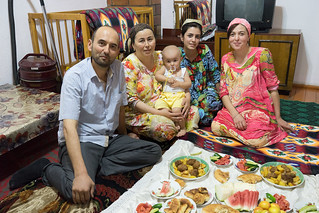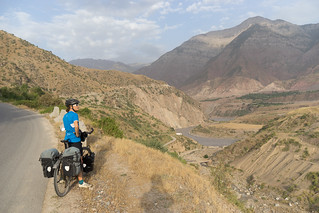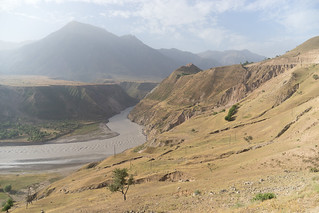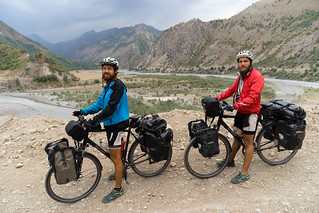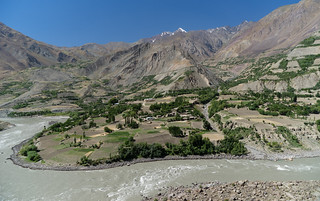For months we had studied the map of Tajikistan and looked forward to reaching Khorog, where we’d start our ride through the remote and beautiful high-altitude Pamir plateau. What we didn’t know was how challenging and stunning it would be just to bike to this town from Dushanbe.
There are two possible routes to Khorog from the capital, and we took the northern one, which is shorter but includes a 3,000 meter pass (sorry everyone, I’ve gone fully metric here in Asia). The first half day of riding seemed normal enough — a paved road following a valley with cotton and other row crops. We left in the late afternoon and spent the first night in a town just 30 km outside of Dushanbe, where yet another family invited us in and fed us dinner.
The next day, the road climbed over a pass and dropped into the first of many canyons. This canyon, carved by the Wakhsh River (a tributary to the Amu Darya), is also the site of the planed Rogun dam, which we’ve heard many people talk about in both Uzbekistan and Tajikistan. It was originally planned by the Soviets in the 1970s, and construction started decades ago, only to be halted. Now the Tajiks are planning to build the dam, which will, when completed, be the world’s tallest earthen dam at over 300 meters (1,000 feet) tall.
Interestingly, unlike in Turkey, where people had very mixed opinions about the country’s zealous building of new dams, in Tajikistan almost everyone we’ve talked to is in favor of Rogun Dam. Currently, most of the country’s electricity comes from a single reservoir. Because natural gas is in short supply, most people in the cities heat their homes with electric heaters. In the winter, because the single reservoir cannot produce enough power, there are rolling blackouts. Everyone we talked with in Dushanbe complained about this. They want more electricity.
The dam will flood what is a spectacular valley and force thousands of people to abandon their homes. In one of the villages that is located near the dam, but that won’t be flooded, I asked if people thought the dam was good or bad. The three people nearby said “karasho,” or “good” in Russian. On the other hand, in one of the small villages that will be underwater, the two people I asked said the opposite.
In Uzbekistan, the few people we talked to about it said the dam should not be built. One person said it was seismically unsafe. The president of Uzbekistan opposes the dam, and he has even threatened war if it is built. Uzbekistan worries that the precious water of the Amu Darya will be held back by this dam, and less will reach the country to irrigate its cotton.
I feel very differently about this dam than the ones I saw in Turkey. I have incomplete information, but I think it probably should be built — Tajikistan needs more energy, and this dam will provide a lot of it without producing much carbon dioxide. It’s sad that people’s homes will be flooded; I hope they are well compensated. Currently, a World Bank study is sorting out the details, and will provide recommendations as to whether the reservoir should be built.
As we rode further up the canyon, the road quality deteriorated, alternating between pavement and dirt. Then a bridge led us across the river and the road followed a tributary. Soon we were on a dirt road between steep rock walls, where we suddenly felt far from civilization. A thunderstorm passed by and we donned our rain jackets for the first time since Georgia.
We spent the night at a mosque with five other cycle tourists — three from Spain and a couple from France. After seeing almost no cycle tourists during our previous three months of travel, we have now seen a few almost every day since leaving Dushanbe. The more we ride here, the more we understand why so many others have decided to as well. The next day, we followed the road as it climbed up several hundred meters and stayed with the Spaniards at the home of a family in a small village at about 2,400 meters in elevation, tucked in a fold in the green mountain slopes. From there, we followed the dirt road over a 3,000 meter pass, and then dropped into a steep canyon, joining the main road to Khorog.
For the next three days, we followed the Panj River upstream – this would be the ride’s highlight. The Panj forms the border with Afghanistan and cuts through a canyon with rock walls rising thousands of meters above the river. There was something almost magical about peering across the river, no more than a few dozen meters wide in places, and seeing the far-away-land of Afghanistan. The road on the Afghan side was always dirt (if it existed), and the towns clearly less developed than the (also poor) Tajik villages we rode through. We saw children running and waving to us, heard an imam give the call to prayer, and watched people threshing wheat. At one point, we watched an elderly couple use a rope to climb from one section of the trail to another that ran far overhead, as the terrain couldn’t support a continuous path. The road on our side was intermittently paved and passed through a small town about every 15 kilometers. Traffic was extremely light, although occasional tractor trailers, carrying goods from China to Dushanbe, passed us.
We spent a night camped above the road peering across at the steep canyon walls, and then another night on the porch of a family we met, who shared soup, bread, stories, and vodka with us. Now we’re finally in Khorog and getting excited for the road ahead. If the ride to Khorog has only been the warm up, we can’t wait for what’s next.







